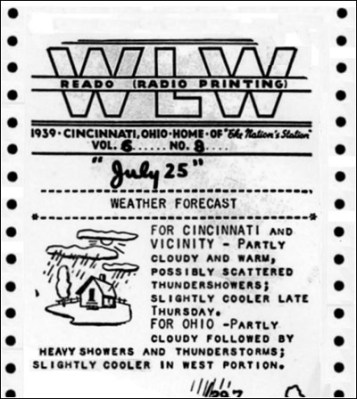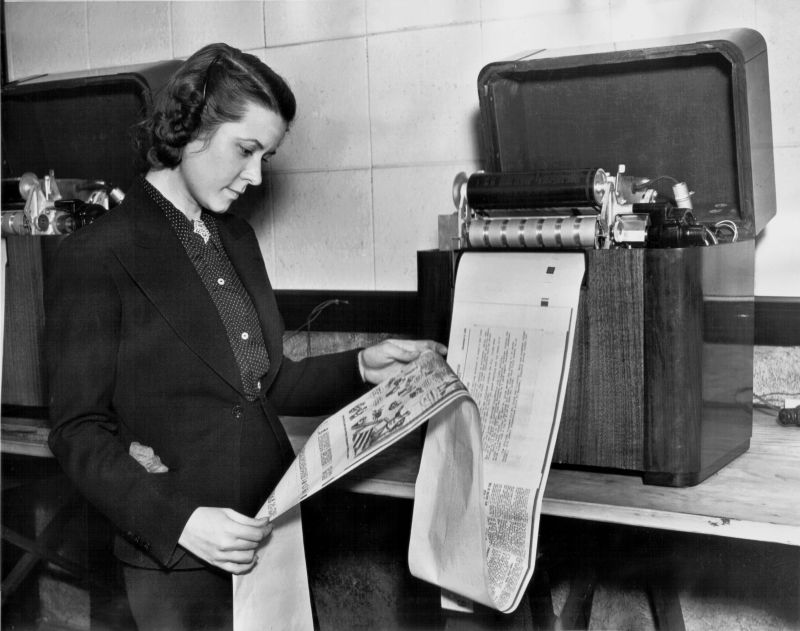We are living in the age of citizen journalism and the 24-hour news cycle. Reports about almost anything newsworthy can be had from many perspectives, both vetted and amateur. Just a few decades ago, people relied on daily newspapers, radio, and word of mouth for their news. On the brink of the television age, several radio stations in the United States participated in an experiment to broadcast news over radio waves. But this was no ordinary transmission. At the other end, a new type of receiver printed out news stories, line drawings, and pictures on a long roll of paper.
Radio facsimile newspaper technology was introduced to the public at the 1939 World’s Fair at two different booths. One belonged to an inventor named William Finch, and one to RCA. Finch had recently made a name for himself with his talking newspaper, which embedded audio into a standard newspaper in the form of wavy lines along the edges that were read by a special device.
Differences in Paper

Both Finch and RCA’s receivers used continuous rolls of paper, but only the RCA units could cut it into sheets. RCA’s paper was 8.5” wide and of standard composition while Finch’s was about half the size and chemically treated. After a while, Crosley got into the game with their Reado receiver, which they sold at Macy’s for a price that undercut both Finch and RCA.
The receiver differences meant that content providers had to consider more than one type of equipment, much like app developers do today. News and photographs laid out on RCA’s standard-width paper would look very different on Finch’s half-width stock.
What’s That Screeching Noise?
If you’ve ever answered the phone when a fax machine is calling, you have some idea of what the radio version of facsimile transmission sounded like. Because of this, the FCC mandated that fax news broadcasts on the AM band be restricted to the hours of 1:00AM and 6:00AM. Several stations transmitted news on the fairly new FM band at all hours of the day. Broadcasters later experimented with multiplexing to transmit audio and facsimile on the same FM frequency.
Too Much New Technology
Proponents of radio facsimile argued that it provided a permanent record for news, and that reports heard over the radio can be easily misheard or misinterpreted. Several radio stations were owned by newspapers, and it was these stations that tried the hardest to satisfy the citizens’ thirst for news with this innovation. Many practitioners viewed the new technology as supplemental to the daily newspaper and radio reports rather than as something that threatened to replace them.
Like any other new technology, the radio newspaper was plagued by the chicken-and-egg problem of consumer adoption. No technology gets off the ground without early adopters, and where there is no audience, there are no advertisers. The receivers averaged 15 minutes to print one page, and this was unappealingly slow for many people. Most household budgets were stretched thin from the Depression and the war so families had to choose between radio newspapers and television. Which would you choose?
In the video below, Hal Wallace of the National Museum of American History gives a brief history of radio newspapers and shows off an RCA unit from 1938.
Author’s note: Send in More Tips!
The way back machine is running on fumes! All we want for Christmas is for you to send in a bunch of Retrotechtacular tips. And soldering iron tips. And beer.
















Never heard of this before – even having read about early fax machines. Pretty cool!
Yeah…strangely enough, very little fax history ever mentions this.
I was very fortunate to visit the storage room of a nice museum on a quest to find a working Dictabelt for another museum. While there, the staff gave me a private tour of the items never shown to the public. One of these was a complete, beginning to end, radio fax collection. Still operational at the time it was donated. Sadly no one knew how to operate it but what I saw was *very* impressive. The transmitter, IIRC, was camera based and each page was scanned and broadcast an analog signal. The receiver model they had was installed in a covered desk. Amazingly, they had rolls of the ‘newspaper” stored away in excellent condition and of waaaaay better quality than the craptastic faxes we have today.
And yes, it did time to print each page so there was a definite trade off there.
After I borrowed what I came there for, I went on a personal quest to learn more about their machine. I did find a website that went into great detail, and even better, went into detailed history and mechanics of that *specific* machine model. The site lamented that no more of that machine existed. I considered contacting them about the museum’s but never got around to it and have since lost the URL.
I haven’t given it much thought to over the years until reading this HaD article. Suppose I ought to go back to the museum and see if I can get some good photos of their stuff. At the time I didn’t bring a camera.
@SavannahLion, there is an outside chance you can find something in Western Australia as the Western Australian Regional Computer Center at the University of Western Australia had an interest re earlier fax machines, joined them for a while when I first started ‘on the net’ circa 1977 with a fantastic 2400 baud modem, still have my old email address from that time !
Approx 10years ago I was fortunate to visit an “organised enthusiastic computer hoarder” who used to have an original functional ICL card reader along with so much other gear he bought the house in front and along with his just for storage. Even after that a visit to his primary residence meant walking sideways through hallways & clambering over fantastic old era equipment incl large old hi-res Sony monitors etc, family rooms etc to slide past HP’s/PDP-11’s etc In my own collection still have an HP1000 tape reader, Dual Z80 ‘superbrain’, Textronix 4054 with the storage mesh screen etc
The deal at Tony’s was you come over for an open house bbq and were invited to assist getting the gear running, was a great visit for reminiscing with my old friend Paul Repacholi (aka Reptile) who was a DEC/Decus/Alpha enthusiast and IIRC he bought the DEC KL-10 “super computer from Curtin University after they ‘upgraded’ from The Western Australian Institute of Technology that acquired the 512Kbyte 36 word machine in 1975, I was also a keen Macro-10 enthusiast and bought the last copy of the assembler reference manual and is still in Paul’s kids collection as he died from lung cancer. Tony I think is still around and still an enthusiast has moved his 2 houses of gear few years ago to a dedicated facility, a search today finds this (might be time for a visit…)
http://www.aceware.com.au/acms/
And newsletter 2014 http://acms.org.au/data/2014newsletter1.pdf
On the other hand WEFAX, broadcast on shortwave starting after WWII proved to be a very useful service based on this technology.
Interesting to revisit history, many may not know the first commercial “telefax” service was in France in 1865 and before the telephone, odd but true…
https://en.wikipedia.org/wiki/Fax#Wire_transmission
With wireless transoceanic in 1924
https://en.wikipedia.org/wiki/Fax#Wireless_transmission
JCC (Kyodo Japan) and KCNA (North Korea) still broadcast radiofax news. Never been lucky enough to catch a KCNA broadcast, but JCC is easy enough. Of course, wefax (weather fax) is still in use by various coast guards and navies.
Back in the early 90’s as things like this were going out of vogue, you could still receive over HF Associated Press and United Press International radiofax broadcasts. You could even generate false-color pictures from the broadcasts with the right software. I probably still have some examples of catches on 5.25″ floppies somewhere…
When a paper cost a nickle and came out three or four times a day this seems like a solution looking for a problem, still technically neat though.
One would think that the National Museum of American History could afford external mics for their Youtube cameras.
That would require money *and* tech savvy people in the right positions. Evidently a tall order.
In the 90s I worked at an radio station and not that much had changed. The tansmission was via satellite so we needed a dish. It was received via computers but the computers still sent it straight to printer. There were two dot-matrix printers in the newsroom that continuously spit out news stories all day long.
The main receiver for anyone interested was connected to an IBM OS/2 box that nobody really knew much about maintaining. I was curious to check that out but it was a live system so it wasn’t open for playing. That used some sort of propietary network cable to talk to two old IBM AT DOS boxes in the newsroom that ran the two printers. When they died we actually pulled the 286 motherboards, hacked the cases with a dremel and fit in newish Pentium ones. They became really fast booting DOS boxes! Everything had to have dongles on the parallel port in order to validate that we had purchased the software.
They got a brand new dish and receiver shortly before I left however I think I remember hearing that only a few years later that new hardware was relegated to backup status as they finally started using the internet.
I tried the game Playstation 4 and go cool me caught Cheap this website
This process reminds me of a system many ham radio operators use called “slow scan television” or SSTV for short.
There are specific frequencies on the HF, VHF and UHF bands for making these transmissions.
The idea is to send a series of tones to produce an image of your choice
Hams all over the world use this method of expression to display photos, graphics or messages to other hams.